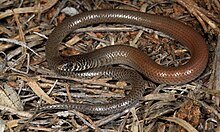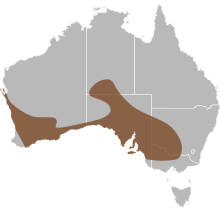|
Marble-faced delma
The Delma australis is often known as the southern legless lizard, or the marble-faced delma.[2] This terrestrial lizard falls into the category of slender Pygopodidae, a legless lizard.[2] There are 21 known species in the Pygopdidae family in Australia.[3] Marble-faced delmas are endemic to Australia.[citation needed] Delma australis was first described by Kluge in 1974.[3] Description D. australis is a brown to reddish brown colour with a greyish undersurface and greyish lips.[2] Their common name, marble-faced delma, comes from their grey-marble appearance. Distinctive features include ventral black bars on the top and sides of head with a short and rounded snout, and a tail twice the length of their body.[2] Geographical variation have been observed in marble-faced delma populations, the intensity of head patterning and head form can vary between populations in different areas.[3] There has been suggestions that there are a number of sub-species of D. australis, variation was discovered in Western Australia but further sampling is needed to determine if these differences were taxonomically significant.[3] EcologyMarble-faced delmas are classified as diurnal, however, have been observed in active states at night or around dawn and dusk.[2] They are often found in leaf litter, under rocks or in spinifex.[2] Classified as terrestrial, but can successfully climb hummock grass and branches of small shrubs.[2] DistributionMarble-faced delmas are widely distributed across southern Australia.[3] They are found to inhabit semi-arid to arid areas in southern Western Australia, most of South Australia, southern Northern Territory, north-west Victoria, and south-west New South Wales.[2] They are terrestrial, or land dwelling, species that are commonly found in spinifex grass.[2] Distribution in New South WalesMarble-faced delma populations are known to be in the Broken Hill Complex Interim Biogeographic Regionalisation of Australia Region, in some of the sub-regions of the Cobar Peneplain Interim Biogeographic Regionalisation of Australia Region, and in sub-regions of the Murray Darling Depression Interim Biogeographic Regionalisation of Australia Region.[4][5][6] In these areas the species in known to be within different vegetation formation and classes, including the Stony Desert Mulga Shrublands which is an Acacia sub-formation, Dune Mallee Woodlands which is a shrubby sub-formation, and Sand Plain Mallee Woodlands.[4][5][6] These areas are arid to semi-arid warm zones.[4] ReproductionMarble-faced delmas reproduce sexually and are oviparous (egg layers), with a clutch size of 2.[7] The eggs hatch after approximately 70 days.[2] They are precocial, meaning they are hatched in an advanced state where they are able to feed themselves and independently move.[citation needed] DietConsidered insectivores, they actively hunt for their food which primarily consists of insects and spiders.[8] Conservation The conservation status of marble-faced delmas in New South Wales is endangered, their conservation status is not listed in the Commonwealth.[2] Degradation of their habitat and losses in their population can be attributed to land use for agricultural purposes.[9] Over-grazing by livestock and feral species within their habitat affects the density and structure of spinifex.[9] Weed invasion and degradation of soil structure within the Mallee-spinifex habitat has also led to habitat loss for the Marble-faced delma populations.[9] ThreatsThreats of the marble-faced delma include: habitat clearance; an increase in fire frequencies reducing the amount of ground cover; predation; loss of leaf litter; heavy grazing and habitat trampling by stock, feral goats, rabbits and pigs.[2] PredationPredation is not a major threat, although it is likely foxes are a predator of the marble-faced delma.[2] References
|
||||||||||||||||||||||||||||||||


